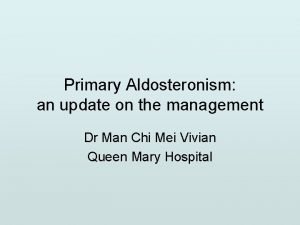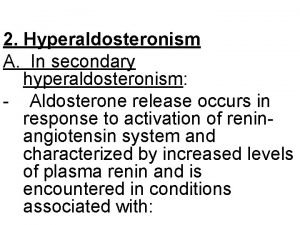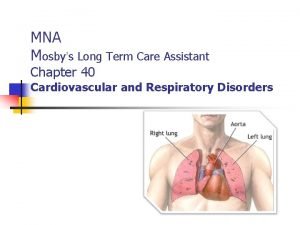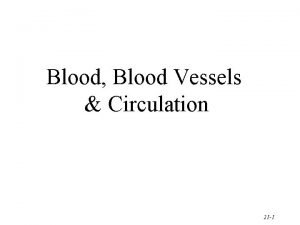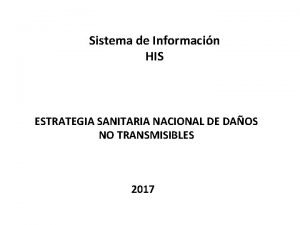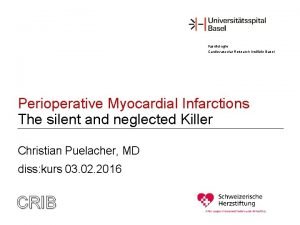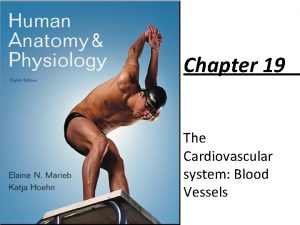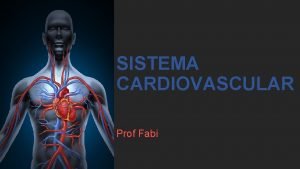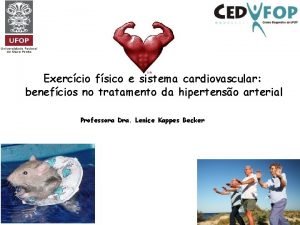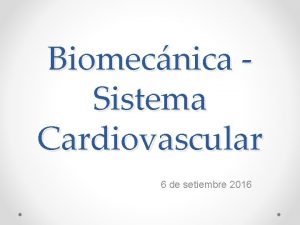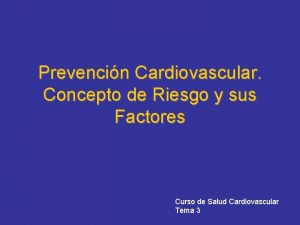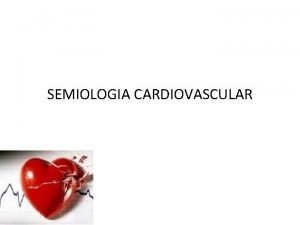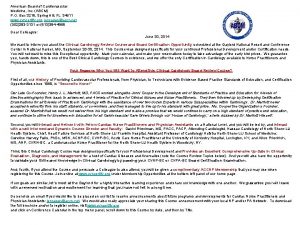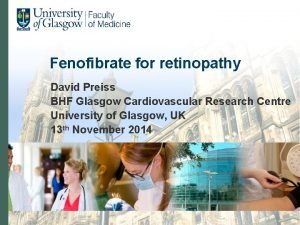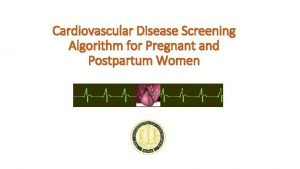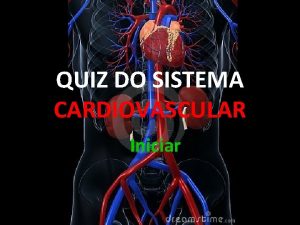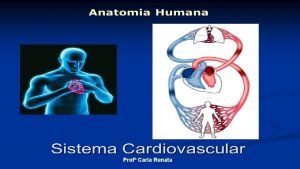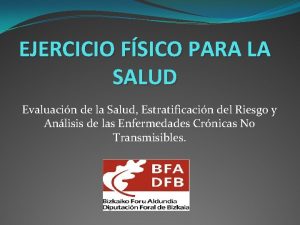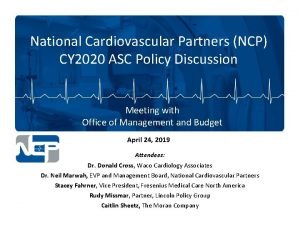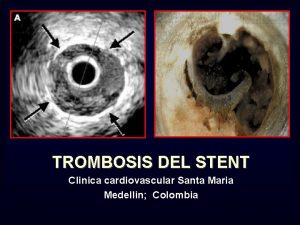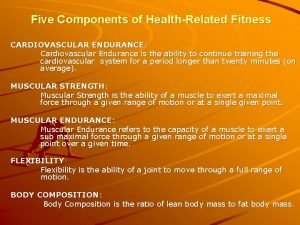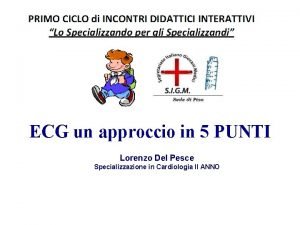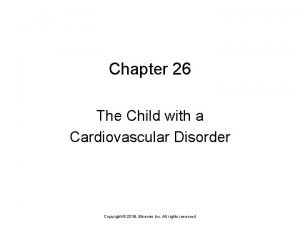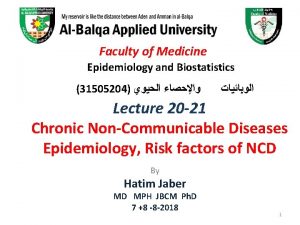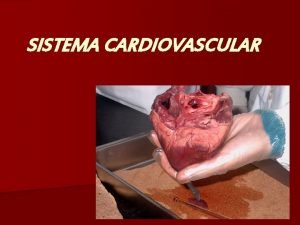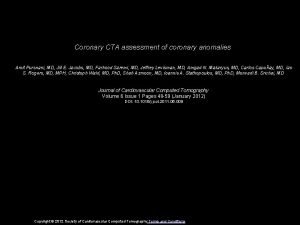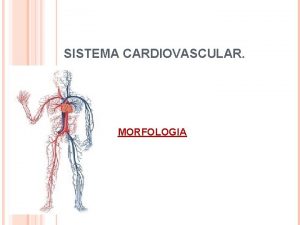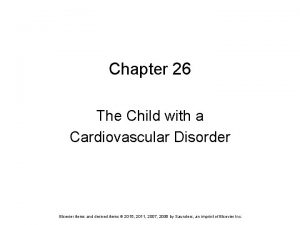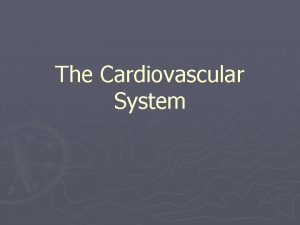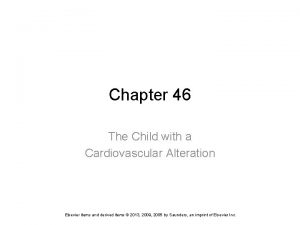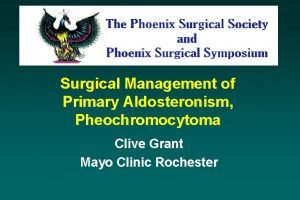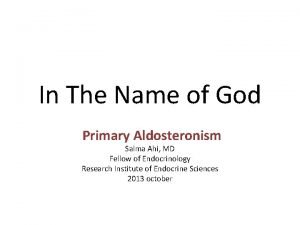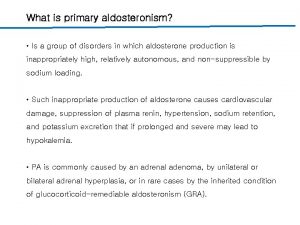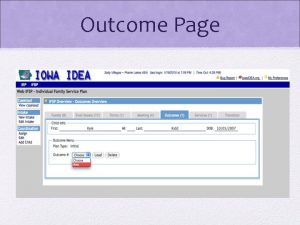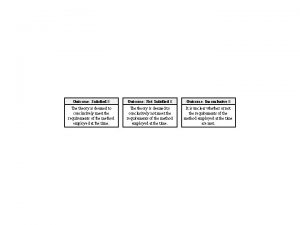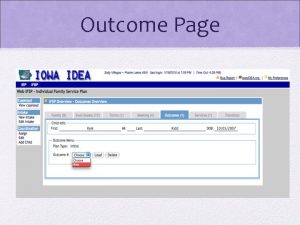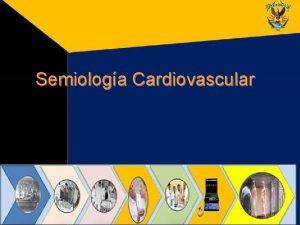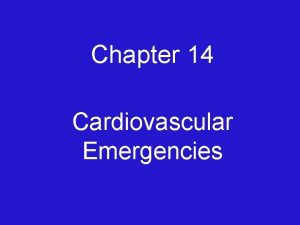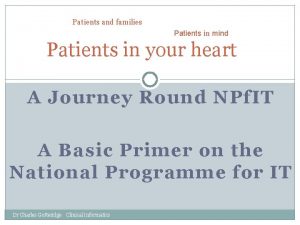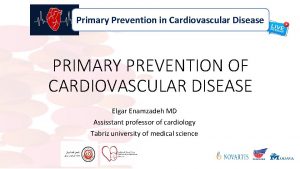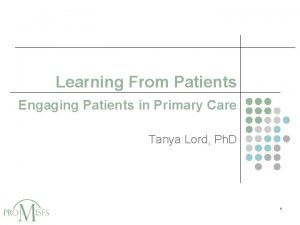compare cardiovascular outcome in Primary aldosteronism with patients
























































- Slides: 56


compare cardiovascular outcome in Primary aldosteronism - with patients with essential hypertension. - with surgery or medical treatment Dr. Bijan ghobadian Shaheed Beheshti University of Medical Sciences

Agenda • Introduction. • studies compare the cardiovascular outcome In PA patients vs essential hypertension. • studies compare the cardiovascular outcome In PA patients with surgery or medical treatment.

• Introduction. • studies compare the cardiovascular outcome In PA patients vs essential hypertension. • studies compare the cardiovascular outcome In PA patients with surgery or medical treatment.

Introduction • Primary aldosteronism (PA) is an endocrine disorder associated with high blood pressure and suppressed plasma renin in which excess circulating aldosterone is caused by an adrenal adenoma (APA) or bilateral adrenal hyperplasia (IHA) and is not suppressible by volume expansion. • Recent evidence indicates a greater frequency of PA among hypertensive patients than the previously accepted prevalence of approximately 1 %.

• This might result from more effective identification of this condition due to widespread use of the plasma aldosterone-to-renin ratio as a screening test. • Structural and functional changes of the heart are consequences of all hypertensive states and have also been detected in patients with PA along with additional subclinical cardiovascular endpoints.

• Introduction • studies compare the cardiovascular outcome In PA patients vs essential hypertension. • studies compare the cardiovascular outcome In PA patients with surgery or medical treatment

Cardiovascular Outcomes in Patients With Primary Aldosteronism After Treatment. Cristiana Catena, MD, Ph. D; Gian. Luca Colussi, MD; Elisa Nadalini, • Prevalence of cardiovascular events in 59 patients with PA diagnosed hypertension unit from January 1, 1994, and December 31, 2001 and 323 compared with controls with EH. • A history of cardiovascular events was reported in 34 patients (11%) with essential hypertension and in 19 (35%) with primary aldosteronism (odds ratio, 4. 61), with a significantly higher prevalence of coronary heart disease, cerebrovascular events, and sustained arrhythmias in patients with primary aldosteronism than in those with essential hypertension ARCH INTERN MED/VOL 168 (NO. 1), JAN 14, 2008

• Multivariate analysis indicated that the variables independently associated with a history of cardiovascular events were age (P. 001), duration of hypertension (P. 001), mean blood pressure (P=. 008), current smoking status (P=. 01), and diagnosis of primary aldosteronism. • no significant associations were found with sex, body mass index, plasma lipid levels, diagnosis of primary aldosteronism, or specific drug types taken during follow-up.

• A proportional hazards model showing that age older than 52 years (HR, 1. 61; 95% CI, 1. 17 -2. 28; P=. 01) and a history of hypertension lasting more than 10 years (HR, 1. 52; 95% CI, 1. 11 -2. 15; P=. 03) were significant adverse factors. • Actuarial analysis of patients treated with adrenalectomy vs aldosterone antagonists did not reveal significant differences in the occurrence of the combined cardiovascular end point (HR, 1. 26; 95% CI, 0. 36 - 4. 44; P=. 71)

Key message • This study demonstrates that primary aldosteronism is associated with a prevalence of cardiovascular complications out of proportion to blood pressure that benefits substantially from treatment in the long term. • adrenalectomy and aldosterone antagonists seem to be of considerable therapeutic value to the extent that, with adequate blood pressure control, they limit the progression of cardiovascular disease.


Observational Study Mortality in Treated Primary Aldosteronism. The German Conn's Registry. Martin Reincke, Evelyn Fischer, Sabine Gerum, Katrin Merkle, • In this study we analyzed all-cause and cardiovascular mortality in a cohort of 337 patients with PA compared with a cohort of control subjects with and without hypertension. • Subtype differentiation between aldosteroneproducing adenoma and bilateral adrenal hyperplasia was based on adrenal imaging. Hypertension. 2012; 60: 618 -624

• 5 - and 10 -year overall survival of patients with PA was similar to that of hypertensive controls (not significant) • Cardiovascular causes were the main cause of death in the cohorts but were more frequent in PA than in controls (50% versus 34% in hypertensive controls [P<0. 05%] versus 38% in normotensive controls). • Assuming that two thirds of the unknown causes of death are attributable to cardiovascular death, the differences to hypertensives and normotensives are highly significant (P=0. 004 and 0. 02, respectively).

• adrenalectomy (as compared with medical treatment of PA) was associated with reduced all-cause mortality and proved to be protective. • Initial plasma aldosterone, plasma renin levels, initial blood pressure, and lipid concentrations had no significant effect on all-cause mortality. • Angina pectoris (HR, 3. 6 [95% CI. 1. 04– 12. 4), and diabetes mellitus (HR, 2. 55 [95% CI, 1. 07– 6. 09]) were associated with an increase in mortality, whereas the presence of hypokalemia (HR, 0. 41 per mmol/L [95% CI, 0. 17– 0. 99]) was associated with a reduced mortality.

Kaplan-Meier survival plot of patients with primary aldosteronism (PA; n=300) vs normotensive (n=600) and hypertensive controls (n=600) matched for age, sex, and body mass index (BMI). Reincke M et al. Hypertension. 2012; 60: 618 -624 Copyright © American Heart Association, Inc. All rights reserved.

Key message Mortality rates of treated patients with PA proved to be not different from those of matched hypertensives. In the future, earlier detection of PA and more intensive blood pressure management after diagnosis hold the promise of a better outcome than shown in our study.

Long-Term Control of Arterial Hypertension and Regression of Left Ventricular Hypertrophy With Treatment of Primary Aldosteronism Gian Paolo Rossi, Maurizio Cesari, Cesare Cuspidi, Giuseppe Maiolino, • To the aim of assessing the effect of treatment of PA on BP and LV changes, we prospectively recruited 323 patients in a long-term follow-up study entailing serial echocardiography evaluations. Of them, 180 had PA and were assigned to either adrenalectomy (n=110) or medical therapy (n=70) on the basis of the adrenal vein sampling. • The remaining 143 were optimally treated EHypertensive patients. HYPERTENSIONAHA. 113. 01316

• The interventricular septum (P<0. 05) and the LV posterior wall (P<0. 001) thickness were higher in patients with PA than in PH, which translated into a higher left ventricular mass index (51. 8± 0. 9 g/m 2. 7 versus 50. 0± 0. 9; P=0. 027). $


• the patients with PA had a 7. 2 -fold higher prevalence of history or current AF than the patients with PH. • Two patients had history of stroke and 1 of hospital admission for acute decompensated heart failure in the PA group,


• The present larger series of patients with PA submitted to a longer follow-up allowed us to document a prominent and persistent decrease in LV mass index in the adrenalectomized patients, and a borderline significant fall in the medically treated patients with PA which might suggest the superiority of adrenalectomy over medical treatment in regressing LVH& improved outcome. • specific treatment of PA was unable to induce complete regression of the adverse changes involving the LV.


Key message • As earlier study , an early diagnosis and a specific treatment of PA warrant normalization of BP and reversal of detrimental LV changes at long term. • Against earlier study adrenalectomy over medical treatment in regressing LVH& improved outcome.

Cardiovascular Complications Associated With Primary Aldosteronism A Controlled Cross-Sectional Study Sébastien Savard, Laurence Amar, Pierre-François Plouin • The aim of this study was to compare the prevalence of cardiovascular events in a large group of current patients with PA and suitably matched controls with essential hypertension (EH) to confirm the adverse cardiovascular effects of PA. • compared the prevalence of cardiovascular events in 459 patients with PA diagnosed in our hypertension unit from 2001 to 2006 and 1290 controls with EH. Hypertension. 2013; 62: 331 -336

• The residual excess risk may be attributable to a direct effect of hyperaldosteronism on target organs or to unmeasured hemodynamic confounders, such as higher nighttime BP, • we found that cardiovascular complications were not more frequent in PA patients with higher aldosterone levels.

• Aldosterone and Target Organ Damage: • proinflammatory, prothrombotic, and profibrotic effects • Mechanisms: chronic intravascular fluid retention, oxidative stress, endothelial dysfunction, inflammation, remodeling, hypertrophy, and fibrosis.

• We show that patients with PA more frequently have LVH and are at higher risk of cardiovascular complications than matched EH controls. • This finding is consistent with previous data suggesting that the higher risk of cardiovascular events associated with PA is at least partly independent of BP.


Key message • like previous investigations , this study showed, that PA is associated with a higher prevalence of LVH and cardiovascular complications than EH. • Despite previously reported & the higher frequency of cardiovascular complications in patients with PA than in those with EH, the absolute prevalence and the difference from matched controls were smaller than those.

• Introduction. • studies compare the cardiovascular outcome In PA patients vs essential hypertension. • studies compare the cardiovascular outcome In PA patients with surgery or medical treatment.

Adrenalectomy Is Comparable With Medical Treatment for Reduction of Left Ventricular Mass in Primary Aldosteronism: Meta-Analysis of Long-Term Studie Luigi Marzano, 1 Gianluca Colussi, 1 Leonardo A. Sechi, 1 and Cristiana Catena 1 • aim of this study was to conduct a meta-analysis of the available studies with long-term follow-up of PA patients treated with either surgery or medical treatment to compare the effects of these treatments on LV mass. • inclusion criteria: (i) prospective studies focused on hyperaldosteronism; (ii) use of confirmatory test in diagnosis of PA; (iii) inclusion of patients with both APA and IHA; (iv) studies with both surgical and medical treatment of PA; (v) LV mass index included as an outcome variable of treatment; and (vi) echocardiographic follow-up >6 months. American Journal of Hypertension, Ltd 2014.

• The literature search identified 2, 655 articles for eligibility and identified 61 potentially relevant studies, 4 met our inclusion criteria for final meta-analysis. • studies included a total of 355 patients with PA, 172 (48%) of whom had IHA and 183 (52%) of whom had APA.


• One 178 patients with APA were treated with adrenalectomy , and the remaining 177 patients received MR antagonists. In these patients, spironolactone was started at a dose that ranged 50– 100 mg/ day and titrated up to 200– 300 mg/day. • LV mass was normalized by body surface area in 1 study and by height in 3 studies. In the latter studies, pretreatment values of LV mass index were comparable in the groups of PA patients who were treated with surgery (54. 5 ± 1. 9 g/m 2. 7) or MR antagonists (55. 5 ± 1. 9 g/m 2. 7).

• Average decrease in blood pressure at the end of follow-up as compared with baseline was greater in PA patients treated with adrenalectomy than in those treated with MR antagonists (systolic blood pressure: − 28 ± 3 mm Hg vs. − 23 ± 3 mm Hg, respectively; diastolic blood pressure: − 19 ± 2 mm Hg vs. − 13 ± 2 mm Hg, respectively). • Hypertension cure was obtained in 44% of PA patients treated with surgery, whereas it was highly variable (from 37% to 0%) in those medically treated. Both medical (− 7. 1% ± 4. 8%) and surgical (− 12. 5% ± 5. 1%) treatment reduced LV mass index, whereas no significant changes were observed in relative wall thickness with both treatments

Meta-analysis of the selected studies demonstrated no significant difference in LV mass change between patients with PA who were treated with adrenalectomy or medical treatment with MR antagonists.

• Hypertension may persist after adequate treatment of PA, and less than half of patients treated with either surgery or MR antagonists have their blood pressure normalized without the use of additional antihypertensive agents. • Previous studies identified older age of patients, longerduration of disease, heavier antihypertensive therapy, and decreased renal function at diagnosis as factors associated with persistence of hypertension after correction of PA. Recent studies suggest also the possibility that autoantibodies to the angiotensin II type I receptor might contribute to residual hypertension in patients treated for PA.

• Only 1 of the studies included in this analysis reported significant effects of medical treatment of PA on LV mass, although these effects required a longer time to occur than those of surgery. Two studies reported decrease of LV mass both in surgically and in medically treated PA patients, but changes were statistically significant only in the former group. The last study did not find any change in LV mass of patients treated with MR antagonists.

Key message • Our meta-analysis indicates that the effects of these treatments are not significantly different. • This might induce physicians to reconsider the need for surgery in all APA patients under a different light.

Long-term effects of adrenalectomy or spironolactone on blood pressure control and regression of left ventricle hypertrophy in patients with primary aldosteronism Tomás Indra, Robert Holaj, Branislav Strauch, Ján Rosa, Ondrej Petrák , • we evaluated the impact of adrenalectomy or conservative treatment with aldosterone antagonists on myocardial alteration on long-term follow-up. • Thirty-one patients with PA were recruited. • A total of 15 patients with confirmed PA were diagnosed with aldosterone-producing adenoma and underwent adrenalectomy. In the other 16 PA patients, conservative treatment was initiated. Journal of Renin-Angiotensin-Aldosterone System 30 September 2014

• Adrenalectomy cured hypertension (i. e. patients had normal blood pressure without any antihypertensive medication) in five cases (33%), and significantly improved blood pressure control in the others; • In the conservative group, adding spironolactone to combined treatment led to blood pressure normalisation in 12 cases (75%) with a significant drop in blood pressure in the rest of the patients.

• It revealed that although both methods can induce a long-term decrease in blood pressure and improve LV diastolic filling, adrenalectomy is more effective in LV hypertrophy reduction and reverses both LV wall thickening and LV cavity enlargement. • Spironolactone treatment resulted in the reduction of the size of the LV cavity only


Key message • although both methods can induce a long-term decrease in blood pressure and improve LV diastolic filling, Against earlier study adrenalectomy is more effective in LV hypertrophy reduction and reverses both LV wall thickening and LV cavity enlargement. • Spironolactone treatment resulted in the reduction of the size of the LV cavity only.

Long-Term Cardiac Effects of Adrenalectomy or Mineralocorticoid Antagonists in Patients With Primary Aldosteronism 2007 Cristiana Catena, Gian. Luca Colussi, Roberta Lapenna, Elisa Nadalini, • We have further explored the relationship between aldosterone and the heart by assessing, in the long term, cardiac anatomic and functional evolution of patients with primary aldosteronism after treatment with adrenalectomy or aldosterone antagonists. • 54 consecutive patients with primary aldosteronism were included in a prospective study. • 84% patients with primary aldosteronism were taking multiple-drug treatment with an average of 2. 9 drugs per patient. Hypertension. 2007; 50: 911 -918

• The LV geometric pattern was defined by the ratio of the posterior LV wall thickness to one half of the LV internal dimension. The LV mass index (LVMI) was calculated by the Penn Convention formula and adjusted for body height with.

• Adrenal adenoma was demonstrated in 29 (54%) of 54 patients with primary aldosteronism, whereas the remaining 25 (46%) had no evidence of adrenal masses. • The average LV internal dimensions and wall thickness had nonsignificant trends to higher values, and the LV mass and LVMI were significantly greater in patients with primary aldosteronism as compared with patients with essential hypertension.

• Blood pressure declined significantly during the first year, with average values that, during the entire course of the study, were of 135/82 and 137/82 mm Hg in patients who were treated with adrenalectomy and spironolactone, respectively. • Treatment was followed by normalization of blood pressure in 21 patients with primary aldosteronism (39%; adrenalectomy: n=10; spironolactone: n=11) and by significant improvement in the remaining 33 (61%; adrenalectomy: n=14; spironolactone: n=19; P=0. 71).

• During the initial 1 -year period, average LV internal dimensions and wall thickness had a nonsignificant trend to decrease in all of the patients with primary aldosteronism. • Subsequent average changes in LV dimensions and wall thickness were greater in patients treated with spironolactone than in those who had adrenalectomy, with an overall change, from baseline to the end of follow-up, that tended to be greater, although nonsignificantly, in adrenalectomized patients.

• After 1 year, plasma renin levels increased significantly in both patients who were treated with adrenalectomy (; P<0. 01) and spironolactone (at the end of follow-up, renin levels were comparable in the 2 treatment groups. • In both adrenalectomized and spironolactone-treated patients, the reduction of LVMI was directly correlated with changes in mean blood pressure (respectively: r=0. 509, P<0. 01 and r=0. 427, P<0. 05) and pretreatment plasma aldosterone concentrations. • Multivariate analysis showed that changes in mean blood pressure (P<0. 05) and pretreatment aldosterone levels (P<0. 05) were both independent predictors of LVMI decrease after treatment, and their respective contributions were 47% and 24%.

• In 108 patients with essential hypertension, the average blood pressure during follow-up was 137/81 mm Hg, and the decrease in LVMI (− 11. 8%) was significantly smaller than in patients with primary aldosteronism (− 17. 4%; P<0. 05), whereas the frequency of reversal of LV hypertrophy (essential hypertension: from 22% to 8%; primary aldosteronism: from 33% to 7%) did not differ significantly between the groups (P=0. 19).

Key message • adrenalectomy and mineralocorticoid receptor blockade appear to be of considerable therapeutic value inasmuch as they significantly reduce LV mass, whereas their beneficial effect on the LV diastolic filling pattern is only partial.

End point • primary aldosteronism is associated with a prevalence of cardiovascular complications out of proportion to blood pressure. • PA is associated with a higher prevalence of LVH and cardiovascular complications than EH. • the effects of these treatments are not significantly different.

Good Luck
 Primary aldosteronism
Primary aldosteronism Oligomenorrea
Oligomenorrea Hyperaldosteronism
Hyperaldosteronism The assistant chapter 40
The assistant chapter 40 Cardiovascular changes
Cardiovascular changes Chapter 7 cardiovascular fitness
Chapter 7 cardiovascular fitness When does stroke volume increase
When does stroke volume increase Cardiovascular system
Cardiovascular system Riesgo cardiovascular por perimetro abdominal
Riesgo cardiovascular por perimetro abdominal Cardiovascular research institute basel
Cardiovascular research institute basel Lesson 11 cardiovascular system
Lesson 11 cardiovascular system Ventriculos
Ventriculos Venule
Venule Foto do sistema cardiovascular
Foto do sistema cardiovascular Aparato cardiovascular
Aparato cardiovascular Cushing reflex
Cushing reflex Anatomy and physiology unit 7 cardiovascular system
Anatomy and physiology unit 7 cardiovascular system Circulatory system tissue
Circulatory system tissue Chapter 11 the cardiovascular system figure 11-3
Chapter 11 the cardiovascular system figure 11-3 Exercício fisico
Exercício fisico Sistema cardiovascular sus partes
Sistema cardiovascular sus partes Chapter 17 cardiovascular emergencies
Chapter 17 cardiovascular emergencies Crash course circulatory system
Crash course circulatory system Introduction of cardiovascular system
Introduction of cardiovascular system Salud cardiovascular
Salud cardiovascular Soplo protosistolico
Soplo protosistolico American board of cardiovascular medicine
American board of cardiovascular medicine Bhf glasgow cardiovascular research centre
Bhf glasgow cardiovascular research centre Cmqcc cardiovascular toolkit
Cmqcc cardiovascular toolkit Quiz sistema cardiovascular
Quiz sistema cardiovascular Desenho da pequena circulação
Desenho da pequena circulação Atraumatic tip
Atraumatic tip Estratificacion de riesgo cardiovascular acsm
Estratificacion de riesgo cardiovascular acsm Fresenius national cardiovascular partners
Fresenius national cardiovascular partners Chapter 11 the cardiovascular system
Chapter 11 the cardiovascular system Clinica cardiovascular santa maria
Clinica cardiovascular santa maria Chapter 11 the cardiovascular system figure 11-3
Chapter 11 the cardiovascular system figure 11-3 Chapter 11 the cardiovascular system figure 11-2
Chapter 11 the cardiovascular system figure 11-2 Chapter 5 learning exercises medical terminology
Chapter 5 learning exercises medical terminology Chapter 13 cardiovascular system
Chapter 13 cardiovascular system What makes up the cardiovascular system
What makes up the cardiovascular system What is cardiovascular endurance in health related fitness
What is cardiovascular endurance in health related fitness Physical education grade 7
Physical education grade 7 Life
Life Chapter 26 the child with a cardiovascular disorder
Chapter 26 the child with a cardiovascular disorder Cardiovascular disease risk factor
Cardiovascular disease risk factor Sistema cardiovascular
Sistema cardiovascular Dr amit pursnani
Dr amit pursnani Cardiovascular system diseases and disorders chapter 8
Cardiovascular system diseases and disorders chapter 8 Cardiovascular/lymphatic system it's totally tubular
Cardiovascular/lymphatic system it's totally tubular Blood vesel
Blood vesel Características de los vasos sanguíneos
Características de los vasos sanguíneos Chapter 19 cardiovascular system blood
Chapter 19 cardiovascular system blood The child with a cardiovascular disorder chapter 26
The child with a cardiovascular disorder chapter 26 Chapter 11 the cardiovascular system
Chapter 11 the cardiovascular system The cardiovascular system includes the
The cardiovascular system includes the Chapter 46 the child with a cardiovascular alteration
Chapter 46 the child with a cardiovascular alteration
